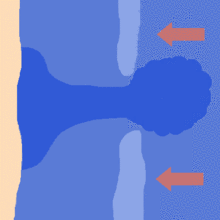- Rip current
-
"Riptide" redirects here. For other uses, see Riptide (disambiguation).
A rip current, commonly referred to by the misnomer rip tide, is a strong channel of water flowing seaward from near the shore, typically through the surf line.[1] Typical flow is at 0.5 metres per second (1–2 feet per second), and can be as fast as 2.5 metres per second (8 feet per second). They can move to different locations on a beach break, up to tens of metres (a few hundred feet) a day. They can occur at any beach with breaking waves, including the world's oceans, seas, and large lakes.[2]
Contents
Causes and occurrence
When wind and waves push water toward the shore, that water is often forced sideways by the oncoming waves. This water streams along the shoreline until it finds an exit back to the sea or open lake water. The resulting rip current is usually narrow and located in a trench between sandbars, under piers or along jetties. A common misconception is that ordinary undertow or even rip currents are strong enough to pull someone under the surface of the water; in reality the current is strongest at the surface. This strong surface flow tends to dampen incoming waves, leading to the illusion of a particularly calm part of the sea, which may possibly lure some swimmers into the area. The off-shore path taken by a rip current can be demonstrated by placing colored dye at the start of a current at the shoreline.[3]
Rip currents are stronger when the surf is rough (such as during high onshore winds, or when a strong hurricane is far offshore) or when the tide is low.
A more theoretical description involves a quantity known as radiation stress. This is the force (or momentum flux) exerted on the water column by the presence of the wave. As a wave shoals and increases in wave height prior to breaking, radiation stress increases. To balance this, the mean surface (the water level with the wave averaged out) decreases—this is known as setdown. As the wave breaks and continues to reduce in height, the radiation stress decreases. To balance this force, the mean surface increases—this is known as setup. As a wave propagates over a sandbar with a gap (as shown above), the wave breaks on the bar, leading to setup. However, the part of the wave that propagates over the gap does not break, and thus setdown will continue. Thus, the mean surface over the bars is higher than that over the gap, and a strong flow will issue outward through the gap.
Rip currents can potentially occur wherever strong longshore variability in wave breaking exists. This variability may be caused by sandbars (as above) or even by crossing wave trains.
Dangers
 Warning sign on the trail to Hanakapiai Beach.
Warning sign on the trail to Hanakapiai Beach.
Rip currents are a source of danger for people in ocean and lake surf.[4] They can be extremely dangerous, dragging swimmers away from the beach. Death by drowning comes following exhaustion while fighting the river or ocean current.
Although a rare event, rip currents can be deadly for non-swimmers as well[citation needed]: a person standing waist deep in water can be dragged into deeper waters, where they can drown if they are unable to swim and are not wearing a flotation device. Varying topography makes some beaches more likely to have rip currents; a few are notorious.
Rip currents cause more than 100 deaths annually in the United States. Rip currents cause 80% of rescues needed by beach lifeguards.[5]
Escaping a rip current
A swimmer caught in a rip current should not attempt to swim back to shore directly against the rip. This risks exhaustion and drowning. A rip does not pull a swimmer under water; it carries the swimmer away from the shore in a narrow channel of water.[1] The rip is like a treadmill which the swimmer needs to step off. The swimmer should remain calm and swim parallel to the shore until he or she is outside of the current. Locations to aim for are places where waves are breaking. In these areas, floating objects are generally transported towards the shore.[6]
A swimmer in a strong rip, who is unable to swim away from it, should relax and calmly float or tread water to conserve energy. Eventually the rip will lose strength, and the swimmer can swim at a leisurely pace, in a diagonal direction, away from the rip but back to shore.[7] Coastal swimmers should understand the danger of rip currents, learn how to recognize them and how to escape from them, and swim in areas where lifeguards are operating, whenever possible.[4]
References
- ^ a b Rip Current Characteristics College of Earth, Ocean, and Environment, University of Delaware. Retrieved 16 January 2009.
- ^ "United States Lifesaving Association's - Rip Currents". www.usla.org. http://www.usla.org/ripcurrents/. Retrieved 2009-07-08.
- ^ Don't get sucked in by the rip... Youtube.com
- ^ a b About Rip Currents United States Lifesaving Association. Retrieved 2 November 2011.
- ^ "NWS Rip Current Awareness Home Page". www.ripcurrents.noaa.gov. http://www.ripcurrents.noaa.gov/. Retrieved 2010-06-06.
- ^ Science of the Surf Educational video
- ^ About Rip Currents United States Lifesaving Association. Retrieved 2 November 2011.
Physical oceanography – Waves and Currents Waves - Airy wave theory
- Ballantine Scale
- Boussinesq approximation
- Breaking wave
- Clapotis
- Cnoidal wave
- Cross sea
- Dispersion
- Infragravity waves
- Edge wave
- Equatorial waves
- Fetch
- Freak wave
- Gravity wave
- Internal wave
- Kelvin wave
- Luke's variational principle
- Mild-slope equation
- Radiation stress
- Rogue wave
- Rossby wave
- Rossby-gravity waves
- Sea state
- Seiche
- Significant wave height
- Sneaker wave
- Soliton
- Stokes drift
- Surf wave
- Swells
- Tsunami
- Undertow
- Ursell number
- Wave base
- Wave–current interaction
- Wave height
- Wave power
- Wave setup
- Wave shoaling
- Wave radar
- Wave turbulence
- Waves and shallow water
- Shallow water equations
- Wind wave
- Wind wave model
- More...

Circulation - Atmospheric circulation
- Baroclinity
- Boundary current
- Coriolis effect
- Downwelling
- Eddy
- Ekman layer
- Ekman spiral
- Ekman transport
- El Niño-Southern Oscillation
- Geostrophic current
- Gulf Stream
- Halothermal circulation
- Humboldt Current
- Hydrothermal circulation
- Global circulation model
- Langmuir circulation
- Longshore drift
- Loop Current
- Maelstrom
- Ocean current
- Ocean dynamics
- Ocean gyre
- Rip current
- Thermohaline circulation
- Shutdown of thermohaline circulation
- Subsurface currents
- Sverdrup balance
- Whirlpool
- Upwelling
- GLODAP
- MOM
- POM
- WOCE
- More...
Tides - Amphidromic point
- Earth tide
- Head of tide
- Internal tide
- Lunitidal interval
- Perigean spring tide
- Rule of twelfths
- Slack water
- Spring/neap tide
- Tidal bore
- Tidal force
- Tidal power
- Tidal race
- Tidal range
- Tidal resonance
- Tide
- Tide gauge
- Tideline
- More...
Physical oceanography – Other Landforms 
Plate tectonics - Black smoker
- Convergent boundary
- Divergent boundary
- Fracture zone
- Hydrothermal vent
- Marine geology
- Mid-ocean ridge
- Mohorovičić discontinuity
- Vine–Matthews–Morley hypothesis
- Oceanic crust
- Outer trench swell
- Ridge push
- Seafloor spreading
- Slab pull
- Slab suction
- Slab window
- Subduction
- Transform fault
- Volcanic arc
- More...
Ocean zones Sea level Acoustics Other - Alvin
- Argo
- Benthic lander
- Color of water
- Marginal sea
- Mooring
- Ocean
- Ocean energy
- Ocean exploration
- Ocean observations
- Ocean pollution
- Ocean reanalysis
- Ocean surface topography
- Ocean thermal energy conversion
- Oceanography
- Pelagic sediments
- Sea surface microlayer
- Sea surface temperature
- Seawater
- Science On a Sphere
- Thermocline
- Underwater glider
- Water column
- World Ocean Atlas
- NODC
- More...
Categories:
Wikimedia Foundation. 2010.




